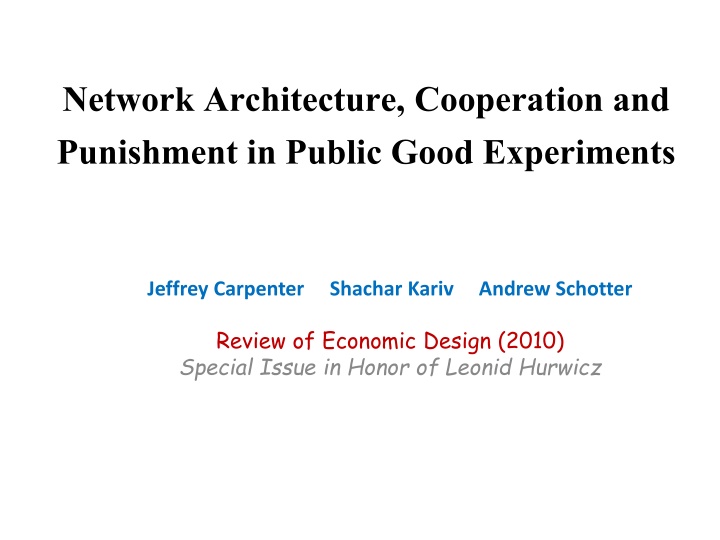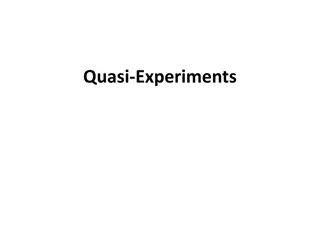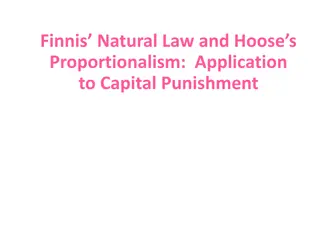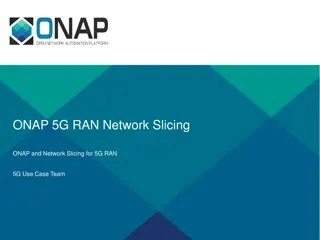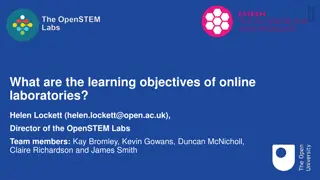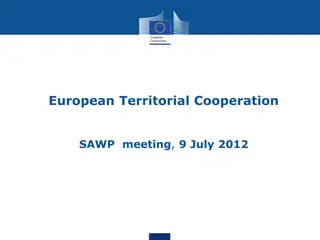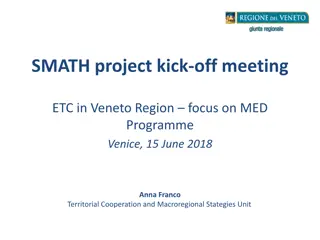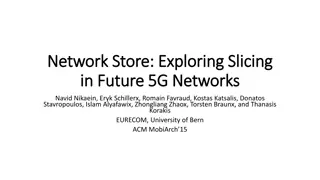Network Architecture: Cooperation and Punishment in Public Good Experiments
This study explores if self-interested individuals can cooperate for socially efficient outcomes in public good experiments. It investigates the impact of partial monitoring and network structures on cooperation, provision, punishment, and efficiency within different network architectures.
Download Presentation

Please find below an Image/Link to download the presentation.
The content on the website is provided AS IS for your information and personal use only. It may not be sold, licensed, or shared on other websites without obtaining consent from the author.If you encounter any issues during the download, it is possible that the publisher has removed the file from their server.
You are allowed to download the files provided on this website for personal or commercial use, subject to the condition that they are used lawfully. All files are the property of their respective owners.
The content on the website is provided AS IS for your information and personal use only. It may not be sold, licensed, or shared on other websites without obtaining consent from the author.
E N D
Presentation Transcript
Network Architecture, Cooperation and Punishment in Public Good Experiments Jeffrey Carpenter Shachar Kariv Andrew Schotter Review of Economic Design (2010) Special Issue in Honor of Leonid Hurwicz
Motivation Can self interested individuals cooperate to achieve socially efficient outcomes? Typical public goods experiments find provision to be low Fehr and Gachter (2000): If contributions can be monitored and those not contributing punishable, provision is high! This strand of literature assumes full monitoring
Motivation In practice, individuals are bound by a social network Monitoring can only be partial! Questions Can partial monitoring restore cooperation? Does the network structure matter? If so, how in terms of provision, punishment and efficiency?
Networks 8 different 4 person networks 3 global properties: completeness, connectedness and directedness 1 local property of the neighborhoods defining the graph: degree
Networks Network [1] is complete, the others are not Networks [1]-[4] are connected and the others are not. In networks [7]-[8] there is connectedness within the subgraph Networks [2] and [5]-[7] are directed and the others are not
Public goods game Each subject has y tokens Stage 1: Subjects simultaneously contribute 0 ?? y Payoffs: ?? and 0.25 < < 1 is the MPCR. 1= ? ??+ ? ? where ? = ?? This condition ensures that contributing is socially efficient but strictly dominated for any individual.
Public goods game Stage 2: Subjects learn individual contributions and can punish those that they are connected to by taking away tokens from them The cost of reducing one token is 0 < c < 1. ? ?? ? 1 ? ?? Payoff: ??= ??? 0,??
Public goods game Punishment cannot deter free-riding under any networks architecture. This follows by Backward Induction.
Experiment Done at NYU and UC Berkeley Undergraduate students with no prior experience in these types of experiments y = 25; = 0.4 and c = 0.5. Participation fee = $5 Each session had 15 rounds and the network was held constant in each session Same was true for subject type (A, B, C, D)
Experiment In each round the 4 person network was formed randomly by drawing one person from each of the 4 types At the end of Stage 1, subjects knew the contributions of the persons they were connected to and total group contribution At the end of Stage 2 they knew their total payoff net of all punishment decisions
Questions Completeness: Compare [1] to the undirected circle [3] and undirected star [4]. The last 2 are both connected and undirected, but incomplete. Connectedness: Compare directed circle [2] to line [6], because removing one link makes the circle disconnected. Compare [2] to disconnected directed circle [7] and undirected circle [3] to disconnected undirected circle [8].
Questions Directedness: Compare directed and undirected circles [2] and [3] and stars [5] and [4]. Compare disconnected directed and undirected circles [7] and [8]. Degree: Test whether subjects who have same in-degree and out-degree behave differently in different networks
Results: Contributions There is a great deal of variation in contribution depending on the network Connected networks within which everyone is monitored have significantly higher contributions (5 tokens more or 20% more) than disconnected networks. Complete network no different from other connected networks. No difference in other properties
Results: Punishment More punishment is used to maintain or increase contributions in directed networks Completeness and directedness play a role in punishment: In the complete network where policing free-riding is decentralized, sanctions are low. In the directed network, where only one person must sanction, they are high. Punishing involves coordination issues.
Results: Efficiency Connected networks are the most efficient while disconnected networks are the least. Adding or removing edges does not necessarily increase or decrease efficiency. Complete network is better for efficiency since it introduces the possibility of free rd==iding in punishment.
Results: Summing up Optimal number of edges in this game? Based on the results and using efficiency as a criteria, 1-4 edges are good (too few edges), same for 9-12 edges. 5-8 edges is not good (too much punishment relative to contributions). Take away: Network architecture matters for behavior and outcomes in public goods experiments. Connectedness is particularly important for desirable outcomes.
